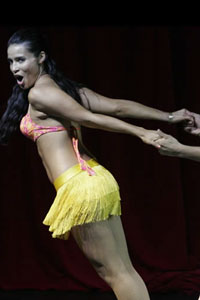Mambo
Type:
 Description
Description
Mambo evolved from a fusion of danzon, son and American jazz. Danzon has its origins from Europe (chamber music) and African/Haitian drum rhythms.
Danzon is the freer more spontaneous version of “Danza” which came to Cuba in the 18th century as “Contradanza” from Spain which came from “Contredanse” at the French Court in the 17th century. It has the typical instruments of Chamber music – violins etc with the addition of African drums. Danzon was danced by wealthy Cuban society where very small steps are taken, the women producing a subtle tilting of the hips by bending and straightening the knees.
Prerez Prado is credited with introducing Mambo at a Havana nightclub in 1943. Tito Rodriguez, Tito Puente and Xavier Cugat also made significant contributions to Mambo’s growth and development.
Mambo arrived in New York around 1947, quickly becoming the new dance craze. Mambo was taught at dance schools, resorts and nightclubs, reaching it’s height of popularity by the mid 1950’s. The fad waned with the birth of Cha Cha, a dance developed from mambo. Recently, it has regained its popularity, due in large part to a New York dancer named Eddie Torres, as well as popular Mambo songs and movies.
Dance Characteristics
Mambo is a fast and spicy dance characterized by strong Cuban motion, staccato movement and expression of rhythm through the body. The dancer holds on counts 1 and break on count 2. Mambo also features press lines, many swivels and spins. The Mambo frame is the same as the Rhythm frame.
Musical Information
Time signature: 4/4
Tempo: 47-51 measures per minute
Timing: 234(1)
Beat value: 1-1-2
